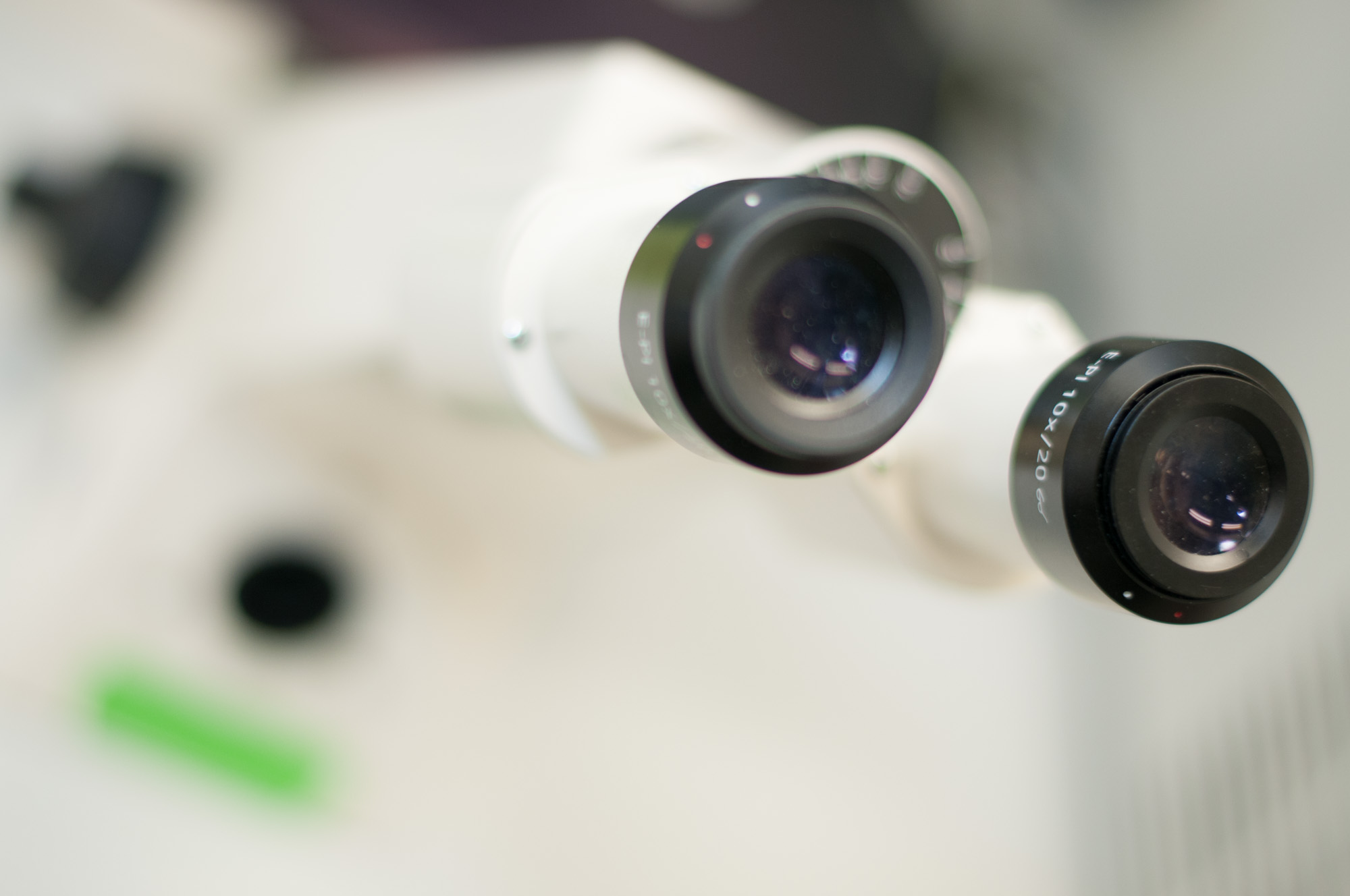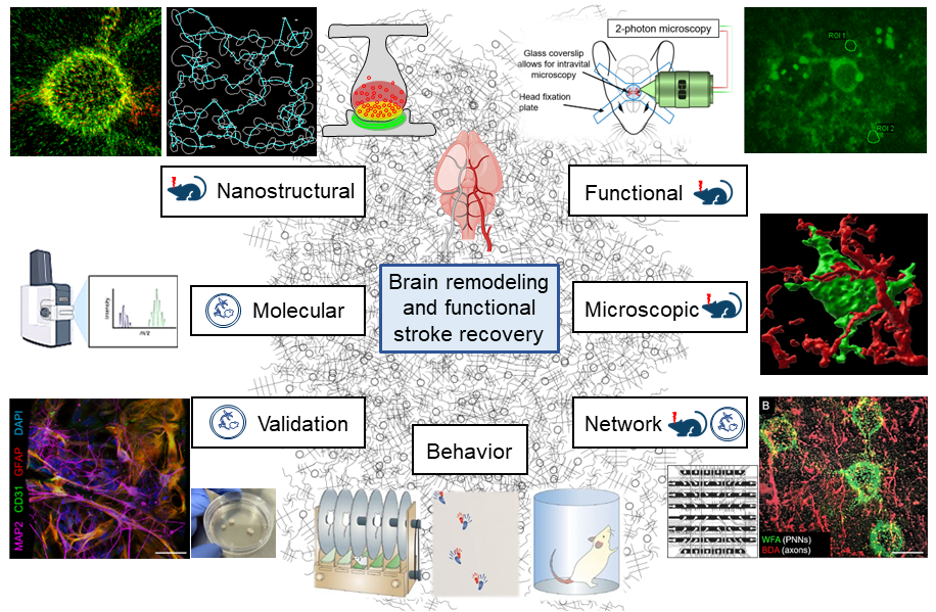
Neuron-glia interactions and extracellular matrix post-stroke
Emerging evidence suggests that changes happening in the brain’s extracellular matrix (ECM), guided by microglia and astrocytes, are vital for how the brain recovers after a stroke. This area is promising but not well explored for stroke treatments.
We’re studying how these complex interactions between the ECM and brain cells affect brain recovery after a stroke. We use advanced technologies including super-resolution imaging, intravital microscopy, calcium imaging, and various tests to see how the brain changes at different levels of organization (see Figure 1). We’re trying to piece together the puzzle of how the brain rebuilds itself after a stroke. Our ultimate goal is to develop new treatments that can help the brain recover better after ischemia. By modulating ECM remodeling and ECM-glia interactions, we aim to promote brain plasticity and recovery after a stroke.
Key research projects:
- The role of extracellular matrix (ECM) in post-stroke motor circuit remodeling
- Molecular mediators of ECM-glia interactions
- Multicellular 3D models of the human neurovascular unit for in vitro studies of brain ischemia
Funding:
DFG project 467228103

Current members
Alumni:
Mina Borbor, PhD
Ben Schmermund, MD
Daniel Manrique-Castano, PhD
Marius Doeckel, M.Sc
Paraskevi Vasileiadou, M.Sc
Publications
2023
Borbor M., Yin D., Brockmeier U., Wang C., Doeckel M., Pillath-Eilers M., Kaltwasser B., Hermann D.M. and Dzyubenko E. Neurotoxicity of ischemic astrocytes involves STAT3-mediated metabolic switching and depends on glycogen usage. Glia 71(6):1553-1569, 2023.
Dzyubenko E. and Hermann D.M. Role of glia and extracellular matrix in controlling neuroplasticity in the central nervous system. Semin Immunopathol 45(3):377-387, 2023.
Dzyubenko E., Willig K.I., Yin D., Sardari M., Tokmak E., Labus P., Schmermund B. and Hermann D.M. Structural changes in perineuronal nets and their perforating GABAergic synapses precede motor coordination recovery post stroke. Journal of Biomedical Science 30(1):76, 2023.
2022
Dzyubenko E., Hermann D.M. and Wang J. Editorial: Perspectives of Astrocytes in Neurodevelopmental and Neurodegenerative Diseases: From Mechanistic Studies to Therapeutic Applications. Frontiers in Cellular Neuroscience 16, 2022.
Dzyubenko E., Manrique-Castano D., Pillath-Eilers M., Vasileiadou P., Reinhard J., Faissner A. and Hermann D.M. Tenascin-C restricts reactive astrogliosis in the ischemic brain. Matrix Biol 110:1-15, 2022.
2021
Dzyubenko E., Fleischer M., Manrique-Castano D., Borbor M., Kleinschnitz C., Faissner A. and Hermann D.M. Inhibitory control in neuronal networks relies on the extracellular matrix integrity. Cell Mol Life Sci 78(14):5647-5663, 2021.
Dzyubenko E., Prazuch W., Pillath-Eilers M., Polanska J. and Hermann D.M. Analysing Intercellular Communication in Astrocytic Networks Using “Astral”. Front Cell Neurosci 15:689268, 2021.
Hermann D.M., Liesz A. and Dzyubenko E. Implications of immune responses for ischemic brain injury and stroke recovery. Brain Behav Immun 96:292-294, 2021.
Manrique-Castano D., Dzyubenko E., Borbor M., Vasileiadou P., Kleinschnitz C., Roll L., Faissner A. and Hermann D.M. Tenascin-C preserves microglia surveillance and restricts leukocyte and, more specifically, T cell infiltration of the ischemic brain. Brain Behav Immun 91:639-648, 2021.
Sardari M., Skuljec J., Yin D., Zec K., de Carvalho T.S., Albers D., Wang C., Pul R., Popa-Wagner A., Doeppner T.R., Kleinschnitz C., Dzyubenko E. and Hermann D.M. Lipopolysaccharide-induced sepsis-like state compromises post-ischemic neurological recovery, brain tissue survival and remodeling via mechanisms involving microvascular thrombosis and brain T cell infiltration. Brain Behav Immun 91:627-638, 2021.
2020
de Carvalho T.S., Sanchez-Mendoza E.H., Melo L.M.N., Moreira A.R.S., Sardari M., Dzyubenko E., Kleinschnitz C. and Hermann D.M. Neuroprotection Induced by Energy and Protein-Energy Undernutrition Is Phase-Dependent After Focal Cerebral Ischemia in Mice. Translational stroke research 11(1):135-146, 2020.
Sanchez-Mendoza E.H., Camblor-Perujo S., Martins Nascentes-Melo L., Dzyubenko E., Fleischer M., Silva de Carvalho T., Schmitt L.I., Leo M., Hagenacker T., Herring A., Keyvani K., Bera S., Kononenko N., Kleinschnitz C. and Hermann D.M. Compromised Hippocampal Neuroplasticity in the Interferon-alpha and Toll-like Receptor-3 Activation-Induced Mouse Depression Model. Mol Neurobiol 57(7):3171-3182, 2020.
Sardari M., Dzyubenko E., Schmermund B., Yin D., Qi Y., Kleinschnitz C. and Hermann D.M. Dose-Dependent Microglial and Astrocytic Responses Associated With Post-ischemic Neuroprotection After Lipopolysaccharide-Induced Sepsis-Like State in Mice. Front Cell Neurosci 14:26, 2020.
Wang C., Borger V., Sardari M., Murke F., Skuljec J., Pul R., Hagemann N., Dzyubenko E., Dittrich R., Gregorius J., Hasenberg M., Kleinschnitz C., Popa-Wagner A., Doeppner T.R., Gunzer M., Giebel B. and Hermann D.M. Mesenchymal Stromal Cell-Derived Small Extracellular Vesicles Induce Ischemic Neuroprotection by Modulating Leukocytes and Specifically Neutrophils. Stroke 51(6):1825-1834, 2020.
2019
de Carvalho T.S., Sanchez-Mendoza E.H., Nascentes L.M., Schultz Moreira A.R., Sardari M., Dzyubenko E., Kleinschnitz C. and Hermann D.M. Moderate Protein Restriction Protects Against Focal Cerebral Ischemia in Mice by Mechanisms Involving Anti-inflammatory and Anti-oxidant Responses. Mol Neurobiol 56(12):8477-8488, 2019.
2018
Dzyubenko E., Manrique-Castano D., Kleinschnitz C., Faissner A. and Hermann D.M. Role of immune responses for extracellular matrix remodeling in the ischemic brain. Ther Adv Neurol Disord 11:1756286418818092, 2018.
Dzyubenko E., Manrique-Castano D., Kleinschnitz C., Faissner A. and Hermann D.M. Topological remodeling of cortical perineuronal nets in focal cerebral ischemia and mild hypoperfusion. Matrix Biol 74:121-132, 2018.
Wang Y.C., Dzyubenko E., Sanchez-Mendoza E.H., Sardari M., Silva de Carvalho T., Doeppner T.R., Kaltwasser B., Machado P., Kleinschnitz C., Bassetti C.L. and Hermann D.M. Postacute Delivery of GABA(A) alpha5 Antagonist Promotes Postischemic Neurological Recovery and Peri-infarct Brain Remodeling. Stroke 49(10):2495-2503, 2018.



